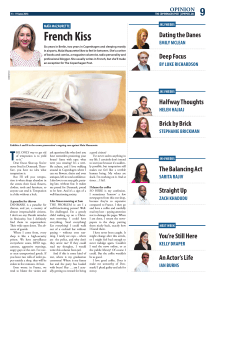
Harilaos N. Psaraftis
Sustainable corridors in Europe: challenges and opportunities Harilaos N. Psaraftis Technical University of Denmark Quick quiz •Are the Motorways of the Sea sustainable corridors? •(you have 3 seconds) 2 DTU Transport, Technical University of Denmark ShortSea 2015, Copenhagen 18/06/2015 •Yes 3 DTU Transport, Technical University of Denmark ShortSea 2015, Copenhagen 18/06/2015 Purpose •Basic questions addressed: •Are the TEN-T core network corridors sustainable (green) corridors? •How does this apply to Short Sea Shipping (SSS) and the Motorways of the Sea (MoS)? •What are challenges and opportunities? 4 DTU Transport, Technical University of Denmark ShortSea 2015, Copenhagen 18/06/2015 TEN-T core network • Regulation EU 1315/2013 (TEN-T guidelines) • Regulation EU 1316/2013 (Connect Europe Facility) 5 DTU Transport, Technical University of Denmark ShortSea 2015, Copenhagen 18/06/2015 TEN-T: 30 priority projects 6 DTU Transport, Technical University of Denmark ShortSea 2015, Copenhagen 18/06/2015 MoS: project No. 21 7 DTU Transport, Technical University of Denmark ShortSea 2015, Copenhagen 18/06/2015 Basics •Q: How is a‘green (sustainable) corridor’defined? •A: An easy question, for which the answer is not so easy 8 DTU Transport, Technical University of Denmark ShortSea 2015, Copenhagen 18/06/2015 Green corridor definitions 9 DTU Transport, Technical University of Denmark ShortSea 2015, Copenhagen 18/06/2015 Keep it simple •Green: Acceptable environmental performance, while at the same time respecting traditional economic performance criteria •Rationale: if traditional economic criteria are not met, solutions may not be viable and trade in a corridor may cease to exist •‘Win-win’ solutions must be sought 10 DTU Transport, Technical University of Denmark ShortSea 2015, Copenhagen 18/06/2015 Making a corridor greener •Before you try to improve something, you should be able to measure it first •Corridor performance can be measured by welldefined Key Performance Indicators (KPIs) 11 DTU Transport, Technical University of Denmark ShortSea 2015, Copenhagen 18/06/2015 Major focus here • “Acceptable environmental performance”: what does it mean? • “Acceptable level of emissions” • [NOTE: there are certainly additional environmental attributes of multimodal transport that create external costs, such as accidents, noise, hazardous substances, oil spills, ballast water, residues, garbage, etc] 12 DTU Transport, Technical University of Denmark ShortSea 2015, Copenhagen 18/06/2015 Types of emissions • Green House GasesGHGs (mainly CO2, but also CH4 and others) • Non-GHG (mainly SOx, but also NOx and others) • P.M., etc 13 DTU Transport, Technical University of Denmark ShortSea 2015, Copenhagen 18/06/2015 Global CO2 emissions 2009 IMO GHG study •(2007 data) 2014 IMO GHG study •(2012 data) • 2.7% reduced to 2.2% • 796 million tonnes of CO2 in 2012, down from 885 million tonnes in 2007 • Mainly attributed to slow steaming due to depressed market conditions after 2008 14 DTU Transport, Technical University of Denmark ShortSea 2015, Copenhagen 18/06/2015 A big challenge 15 DTU Transport, Technical University of Denmark ShortSea 2015, Copenhagen 18/06/2015 2011 Transport White Paper (among other things) • Sets a goal of reducing GHG emissions from transport (all modes) by 60% by 2050 vis-àvis 1990 levels • Q: how can multi-modal transport grow and be profitable in the face of such ambitious environmental goals 16 DTU Transport, Technical University of Denmark ShortSea 2015, Copenhagen 18/06/2015 Green corridor performance •How can it be measured? •Enter •EU FP7, 2010-2013 • www.supergreenproject.eu 17 DTU Transport, Technical University of Denmark ShortSea 2015, Copenhagen 18/06/2015 Key Performance Indicators (KPIs) • Can measure a corridor’s performance • What are reasonable KPIs? 18 DTU Transport, Technical University of Denmark ShortSea 2015, Copenhagen 18/06/2015 Initial list: 17 KPIs Efficiency Absolute cost Relative cost €/tonne €/ton-km Service quality Transport time Reliability (time precision) Frequency of service ICT applications Cargo security Cargo safety hours % of shipments on time number per week scale 1-5 incidents/shipments incidents/shipments Environmental CO2-eq Sustainability SOx NOx PM10 g/ton-km g/1000 ton-km g/1000 ton-km g/1000 ton-km Infrastructural Congestion Sufficiency Bottlenecks average delay/ton-km scale 1-5 Social issues % of buffer zone fatal.& ser.injur./m tkm % of length >50/55 dB 19 Land use (urban & sensitive areas) Traffic safety Noise DTU Transport, Technical University of Denmark ShortSea 2015, Copenhagen 18/06/2015 Process •Methodology •Analysis •4 stakeholder workshops 20 DTU Transport, Technical University of Denmark ShortSea 2015, Copenhagen 18/06/2015 Final list of KPIs (6) 21 Relative transport cost €/ton-km Transport time (or speed) hours (or km/h) Reliability (on-time delivery) % of shipments Frequency of service number per year CO2-eq emissions g/ton-km SOx emissions g/ton-km DTU Transport, Technical University of Denmark 21 ShortSea 2015, Copenhagen 18/06/2015 The 9 SuperGreen corridors 22 DTU Transport, Technical University of Denmark ShortSea 2015, Copenhagen 18/06/2015 The SuperGreen corridors 23 DTU Transport, Technical University of Denmark ShortSea 2015, Copenhagen 18/06/2015 The 9 SuperGreen corridors in metro format 24 DTU Transport, Technical University of Denmark ShortSea 2015, Copenhagen 18/06/2015 The TEN-T core network in metro format 25 DTU Transport, Technical University of Denmark ShortSea 2015, Copenhagen 18/06/2015 SuperGreen corridors (2010) vs TEN-T core network corridors (2011) 26 DTU Transport, Technical University of Denmark ShortSea 2015, Copenhagen 18/06/2015 Benchmarking results 27 DTU Transport, Technical University of Denmark 27 ShortSea 2015, Copenhagen 18/06/2015 Green corridor generic features • Reliance on co-modality adequate transhipment facilities integrated logistics concepts • Reliance on advanced technology energy efficiency use of alternative clean fuels • Development/demonstration of environmentally-friendly and innovative transport solutions, including ICT applications • Collaborative business models 28 DTU Transport, Technical University of Denmark 28 ShortSea 2015, Copenhagen 18/06/2015 Are the TEN-T core network corridors green? All characteristics that make a corridor green are more or less met by the concept of TEN-T core network corridor The new TEN-T policy has established a network of green corridors in Europe Source: Panagakos, G., H.N. Psaraftis, “How green are the TEN-T core network corridors?” TRA 2014 conference, Paris, France, April 2014. 29 DTU Transport, Technical University of Denmark 29 ShortSea 2015, Copenhagen 18/06/2015 What about SSS and the MoS? •For several of the KPIs, SSS is doing better than other modes. •Doing better: Cost, CO2 emissions •Doing worse: Transport time, SOx •Other KPIs: mixed 30 DTU Transport, Technical University of Denmark ShortSea 2015, Copenhagen 18/06/2015 Benchmarking results 31 DTU Transport, Technical University of Denmark 31 ShortSea 2015, Copenhagen 18/06/2015 SOx: IMO MARPOL Annex VI Oct. 2008 32 IMO emission standards are further revised by amendments to Annex VI DTU Transport, Technical University of Denmark ShortSea 2015, Copenhagen 18/06/2015 IMO MARPOL Annex VI 33 DTU Transport, Technical University of Denmark ShortSea 2015, Copenhagen 18/06/2015 EU Directive 2012/33/EC • • The IMO limits are being transposed into European law The 0.5% limit is brought into force on 1 January 2020 for all EU sea territory, even if on global scale this limit gets postponed to 2025 AND • 34 the Commission was asked by the legislation to consider extending the stricter SECA limits to all EU territorial waters DTU Transport, Technical University of Denmark ShortSea 2015, Copenhagen 18/06/2015 35 DTU Transport, Technical University of Denmark ShortSea 2015, Copenhagen 18/06/2015 Basic case study results • Additional cost per cargo tonne: 6.95 €/t • Modal shift (sea to road): 5.2% • Modal shift would also reduce CO2! 36 DTU Transport, Technical University of Denmark ShortSea 2015, Copenhagen 18/06/2015 New DTU project • Mitigating and reversing the side-effects of environmental legislation on Ro-Ro shipping in Northern Europe • Main objective: identify and assess possible technical, operational, regulatory and financial measures for the mitigation and reversal of the negative repercussions of environmental legislation to the market shares of Ro-Ro shipping in Northern Europe. • Sponsor: Danish Maritime Fund • Industry partner: DFDS • Duration: 2 years (2015-2017) 37 DTU Transport, Technical University of Denmark ShortSea 2015, Copenhagen 18/06/2015 Risk •Switching to more expensive fuel might make SSS less competitive vis-a-vis land transport alternatives •Serious concern to SSS operators in Northern Europe •Commission has set up the European Sustainable Shipping Forum (ESSF) to address this problem 38 DTU Transport, Technical University of Denmark ShortSea 2015, Copenhagen 18/06/2015 Lucky break 39 DTU Transport, Technical University of Denmark ShortSea 2015, Copenhagen 18/06/2015 Challenges 40 DTU Transport, Technical University of Denmark Opportunities ShortSea 2015, Copenhagen 18/06/2015 41 DTU Transport, Technical University of Denmark ShortSea 2015, Copenhagen 18/06/2015 Grab the opportunity •A significant emissions reductions potential exists, so long as the following outcomes can be achieved: •The energy efficiency of SSS can be further improved, and/or •Significant traffic can be shifted from other transport modes to SSS 42 DTU Transport, Technical University of Denmark ShortSea 2015, Copenhagen 18/06/2015 A deep-sea paradigm 43 DTU Transport, Technical University of Denmark ShortSea 2015, Copenhagen 18/06/2015 Challenges (technological) •Can something equivalent be developed for SSS? •Innovative designs •Fuel efficient engines •LNG •Scrubbers •Batteries •etc 44 DTU Transport, Technical University of Denmark ShortSea 2015, Copenhagen 18/06/2015 The 2nd pillar Improve energy efficiency Shift traffic from land to sea •Better designs •Better engines •Better propellers •Cleaner fuels •Other technologies •Big role for SSS •Role of ports 45 DTU Transport, Technical University of Denmark ShortSea 2015, Copenhagen 18/06/2015 Challenges (logistical) •Improve efficiency of SSS supply chain – Strategic: network design – Operational: fleet management •Make ports work more efficiently 46 DTU Transport, Technical University of Denmark ShortSea 2015, Copenhagen 18/06/2015 Related challenges •Financial •Governance •Regulatory –enforcement of SECA regulations –MRV –etc 47 DTU Transport, Technical University of Denmark ShortSea 2015, Copenhagen 18/06/2015 Conclusions •SSS and the MoS are well placed to contribute to important EU sustainability goals •Trick: how to do this in the most efficient way 48 DTU Transport, Technical University of Denmark ShortSea 2015, Copenhagen 18/06/2015 Sample references • Psaraftis, H.N., A. Minsaas, G. Panagakos, C. Pålsson, and I. Salanne (2012), ”Green Corridors in European Surface Freight Logistics,” book chapter in Global Logistics, J. Bookbinder (ed.), Springer. • Panagakos G., H.N. Psaraftis, A. Minsaas, I. Ilves, I. Salanne,”The SuperGreen project and green corridor benchmarking” Book on European Green Corridor projects, to be published within the transport logistics series of the “Wildauer Schriftenreihe” (ISBN 978-3-936527-xx). • Psaraftis, H.N., C.A. Kontovas (2012), “Ship Emissions, Costs and Their Tradeoffs,” in Advances in Maritime Logistics and Supply Chain Systems, E.P. Chew, L.H. Lee, and L.C. Tang (eds), World Scientific Books. • Psaraftis, H.N., and C.A. Kontovas (2013), “Speed Models for Energy-Efficient Maritime Transportation: A Taxonomy and Survey,” Transportation Research Part C 26, 331–351. • Panagakos, G., I. V. Stamatopoulou, and H. N. Psaraftis, (2014) “The Possible Designation of the Mediterranean as a SECA: a Case Study,” Transportation Research Part D, 28, 74-90. • Psaraftis, H.N., and C.A. Kontovas (2014), “Ship speed optimization: Concepts, models and combined speed-routing scenarios,” Transportation Research Part C, 44, 52-69. • Fagerholt, K., Gausel, N., Rakke, J., Psaraftis, H., (2015), “Maritime routing and speed optimization with emission control areas,” Transportation Research Part C, 52, 57-63. • Magirou, E.F., H.N. Psaraftis, T. Bouritas, (2015), ” The economic speed of an oceangoing vessel in a dynamic setting,” Transportation Research Part B, 76, 48-67. • Fagerholt, K., H.N. Psaraftis, (2015), ”On two speed optimization problems for ships that sail in and out of emission control areas,” Transportation Research Part D (in press). 49 DTU Transport, Technical University of Denmark ShortSea 2015, Copenhagen 18/06/2015 New book 50 DTU Transport, Technical University of Denmark ShortSea 2015, Copenhagen 18/06/2015 Thank you very much! • hnpsar@transport.dtu.dk 51 DTU Transport, Technical University of Denmark ShortSea 2015, Copenhagen 18/06/2015
© Copyright 2025









